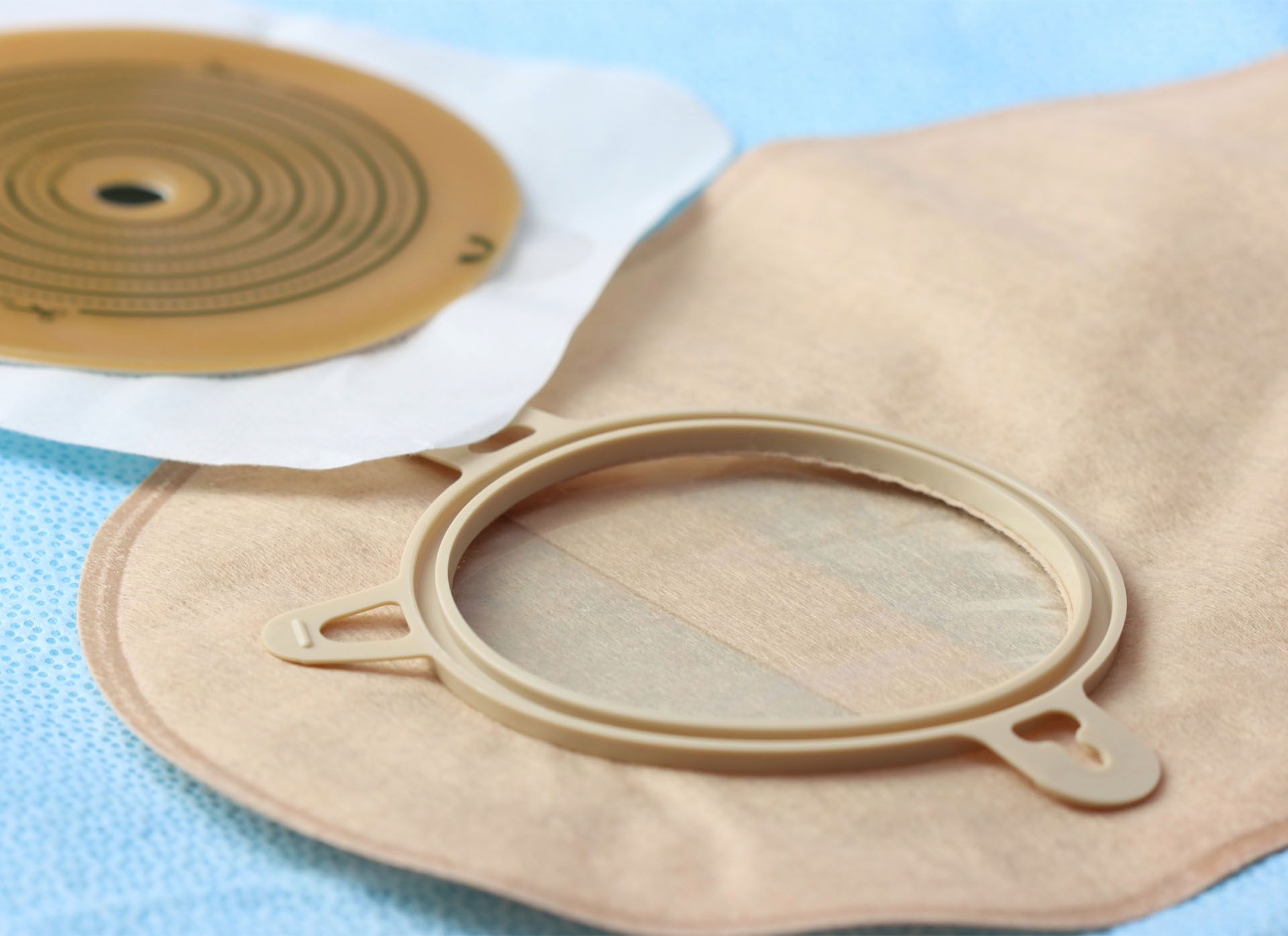Tsitsi 0415 403 313
Hilda 0415 402 516
Living with a colostomy may bring lifestyle changes, but with the right care at home, it can become a manageable and even empowering part of daily life. This guide is designed to help individuals and carers in Australia understand the essentials of colostomy care, especially following ostomy surgery. From managing your supplies to preventing skin irritation, we’ll explore practical steps that help you maintain hygiene, comfort, and confidence.
A colostomy is one type of ostomy surgery, where a section of the colon is brought through the abdominal wall to form a stoma. This allows stool to bypass a diseased or damaged part of the bowel.
This redirection is essential for protecting healing tissues or bypassing damaged or removed sections of the colon. Though it changes the usual route of waste, many people adapt well with the right information, tools, and support.
Depending on the site and function, colostomies can be permanent or temporary. The waste consistency is usually semi-formed to formed, depending on where the colostomy is placed.
Colostomies are generally classified by two factors: the location in the colon and whether they are temporary or permanent. Both influence the consistency of bowel movements, the daily routine, and the kind of colostomy bag system a person may use.
These are typically required when a section of the colon or rectum has been removed or is no longer functional. They are often associated with long-term conditions like cancer or irreversible bowel disease.
Temporary colostomies are created to divert stool while the bowel heals from surgery, trauma, or infection. Once recovery is complete, the bowel may be reconnected.
Here are some of the most common medical reasons for needing a colostomy:
One of the leading causes of colostomy surgery, colorectal cancer, can involve tumour removal that affects the colon or rectum. If the lower bowel or anus is removed, a permanent colostomy may be necessary.
This condition involves inflammation or infection in small pouches (diverticula) that form in the colon wall. In severe or recurrent cases, surgery may be required, and a temporary colostomy might be used to allow the bowel to heal.
Accidents, gunshot wounds, or surgical complications can damage the colon or rectum. A colostomy may be needed to safely divert waste while the affected area heals or if permanent repair isn’t possible.
Blockages in the intestine from scar tissue, tumours, or twisting (volvulus) can require emergency surgery. A colostomy is sometimes necessary to bypass the obstruction and protect the bowel.
Conditions like Crohn’s disease or ulcerative colitis can cause chronic inflammation and tissue damage in the large intestine. In severe cases, removing the affected section and forming a stoma may be the best option.
Some babies are born with abnormalities like imperforate anus or Hirschsprung’s disease, where part of the bowel is missing or malformed. A colostomy may be created early in life to manage waste while preparing for corrective surgery.
Abnormal connections (fistulas) between the bowel and other organs, or life-threatening infections such as peritonitis, can damage intestinal tissue. A temporary colostomy may be required to divert waste and support recovery.
Proper colostomy care revolves around managing the stoma and surrounding skin, using the right equipment like an ostomy bag, and adopting a proactive approach to hygiene and monitoring.
The primary tools in colostomy care include:
A colostomy bag is a type of ostomy bag used specifically for people who’ve had a colostomy—a procedure where a portion of the colon (often the sigmoid colon) is brought through the abdominal wall to form a stoma. This bag collects solid waste (stool) from the large intestine.
A skin barrier is applied around the stoma to protect the skin from irritation caused by digestive enzymes. It also helps the ostomy bag adhere securely to the abdominal wall. These can be in the form of wafers, seals, or sprays.

This tool helps ensure that the opening of the skin barrier matches the size and shape of the stoma, providing a snug fit to reduce the risk of leakage and protect surrounding skin.
To avoid damage during pouch changes, adhesive remover wipes or sprays are used to gently lift the colostomy bag and barrier without pulling on the skin.
Warm water, soft cloths, or non-perfumed wipes are used to clean around the stoma area. Harsh soaps or alcohol-based products should be avoided to minimise irritation.
Used ostomy bags and materials should be discarded in odour-proof disposal bags, which keep the environment hygienic and reduce odour during disposal.
These flexible accessories help fill in uneven skin surfaces, creating a better seal for the pouching system and further preventing leaks.
An ostomy belt or support wear can help hold the pouch securely in place, especially for active individuals or those concerned about the bag shifting.
These are specially made for ostomy pouches to reduce odours and make emptying easier, improving overall comfort and discretion.
Understanding these terms and selecting what works best for you can dramatically improve comfort and prevent complications.
Consistency helps simplify colostomy care. Emptying your ostomy bag when it's about one-third full can help prevent leaks and reduce odours. Most people find that first thing in the morning and before bedtime are the most convenient times for bag maintenance.
Your routine should include:
Every time you change the pouch, check the skin around the stoma for:
These could be early signs of skin irritation, an allergic reaction to adhesives, or infection. Seek advice from a wound ostomy continence nurse if symptoms persist.
Even with a well-established routine, occasional issues may arise in colostomy care. Knowing how to manage these common challenges can make a big difference in daily comfort and confidence.
While modern colostomy bags are designed to be odour-proof, some people may still worry about smells. Here’s how to manage odour discreetly:
Leakage from the colostomy bag can be uncomfortable, stressful, and damaging to the skin. Here's how to stay leak-free:
If leaks persist, consult a wound ostomy continence nurse for a reassessment of your products and routine.
These lifestyle adjustments support healthy digestion, help maintain predictable bowel movements, and improve overall quality of life.
While dietary needs vary from person to person, certain foods are more likely to cause odour or gas, which can be concerning when using a colostomy bag. Identifying your personal triggers and gradually reintroducing foods helps you regain comfort and confidence.
Odour-Causing Foods:
Gas-Producing Foods:
Some foods can also alter the consistency or timing of your bowel movements, so maintaining a food diary can be helpful.
Hydration and good digestion play a central role after ostomy surgery, particularly for those with a transverse colostomy, where output may be less predictable.
Physical activity supports both physical and mental well-being. With some adjustments, you can safely return to a more active lifestyle:
Regular movement also helps reduce the risk of bloating and promotes a more consistent digestive rhythm.
While much of colostomy care focuses on physical health, the emotional journey is just as important. Adjusting to life with a colostomy bag—whether temporary or permanent—can stir a mix of emotions, from relief and hope to fear, frustration, or grief. Recognising and addressing these feelings is key to building a positive, empowered life after ostomy surgery.
What can help:
Countless Australians live with ostomies, and there are vibrant, understanding communities ready to help you feel seen, heard, and supported.
If you're also receiving funded care, you can access these through trusted NDIS nursing services. Our team is here to support you holistically, with both medical expertise and compassionate care.
Caring for someone with a colostomy is a deeply meaningful role. You might assist with practical tasks like changing the colostomy bag, cleaning the stoma, or organising medical supplies. But just as importantly, you're offering emotional support, reassurance, and a calming presence when your loved one needs it most.
It’s important to recognise that caregiving, while rewarding, can also take a toll. Don’t forget to care for your own well-being along the way. It's important to:
Adjusting to life with a colostomy can feel overwhelming at first, but with the right care and information, it quickly becomes a manageable part of daily life. Effective colostomy care at home focuses on protecting the skin, maintaining a secure and comfortable fit, and establishing a simple routine that suits your lifestyle. Recognising small issues early helps prevent complications and supports long-term health.
Whether caring for yourself or assisting a loved one, taking a proactive and informed approach to colostomy care makes a real difference. With practical techniques, the right supplies, and support from health professionals when needed, living with a colostomy can become a positive step towards recovery, independence, and greater confidence in everyday life.


We hope you found this blog helpful!
Flame Lily Australia, a registered NDIS provider, offers comprehensive nursing services, including continence assessments delivered face-to-face or Australia-wide via Zoom. Our face-to-face services are available in Wollongong, Western Sydney, Nowra, and the Southern Highlands. Visit our website here.

Flame Lily Australia, a registered NDIS provider, offers comprehensive nursing services, including continence assessments delivered face-to-face or Australia-wide via Zoom. Our face-to-face services are available in Wollongong, Western Sydney, Nowra, and the Southern Highlands. Visit our website here.

Flame Lily Australia is an NDIS registered service provider offering comprehensive in-home support and specialised medical care for individuals with complex and chronic medical conditions.
We also support My Aged Care recipients through partnership with registered Home Care Package providers.
How Can We Help?
Tsitsi - 0415 403 313
Hilda - 0415 402 516
